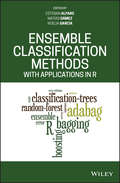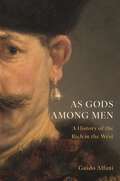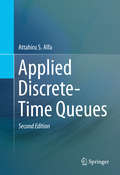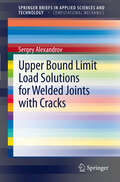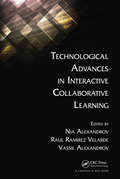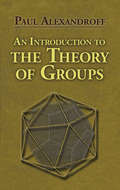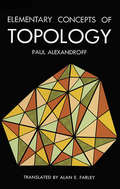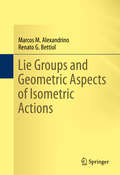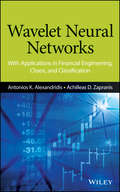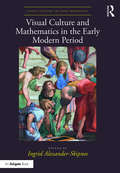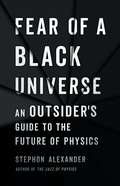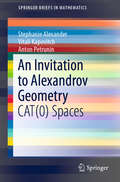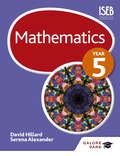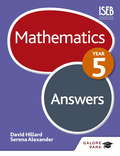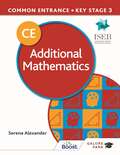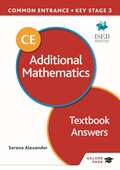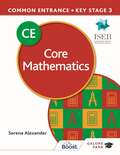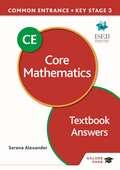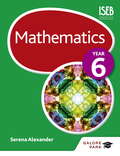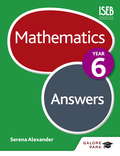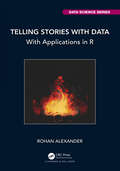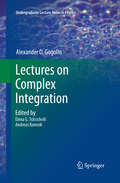- Table View
- List View
Ensemble Classification Methods with Applications in R
by Esteban Alfaro Matías Gámez Noelia GarcíaAn essential guide to two burgeoning topics in machine learning – classification trees and ensemble learning Ensemble Classification Methods with Applications in R introduces the concepts and principles of ensemble classifiers methods and includes a review of the most commonly used techniques. This important resource shows how ensemble classification has become an extension of the individual classifiers. The text puts the emphasis on two areas of machine learning: classification trees and ensemble learning. The authors explore ensemble classification methods’ basic characteristics and explain the types of problems that can emerge in its application. Written by a team of noted experts in the field, the text is divided into two main sections. The first section outlines the theoretical underpinnings of the topic and the second section is designed to include examples of practical applications. The book contains a wealth of illustrative cases of business failure prediction, zoology, ecology and others. This vital guide: Offers an important text that has been tested both in the classroom and at tutorials at conferences Contains authoritative information written by leading experts in the field Presents a comprehensive text that can be applied to courses in machine learning, data mining and artificial intelligence Combines in one volume two of the most intriguing topics in machine learning: ensemble learning and classification trees Written for researchers from many fields such as biostatistics, economics, environment, zoology, as well as students of data mining and machine learning, Ensemble Classification Methods with Applications in R puts the focus on two topics in machine learning: classification trees and ensemble learning.
Applied Optimization in the Petroleum Industry
by Hesham K. AlfaresThe book addresses optimization in the petroleum industry from a practical, large-scale-application-oriented point of view. The models and techniques presented help to optimize the limited resources in the industry in order to maximize economic benefits, ensure operational safety, and reduce environmental impact. The book discusses several important real-life applications of optimization in the petroleum industry, ranging from the scheduling of personnel time to the blending of gasoline. It covers a wide spectrum of relevant activities, including drilling, producing, maintenance, and distribution. The text begins with an introductory overview of the petroleum industry and then of optimization models and techniques. The main body of the book details a variety of applications of optimization models and techniques within the petroleum industry.Applied Optimization in the Petroleum Industry helps readers to find effective optimization-based solutions to their own practical problems in a large and important industrial sector, still the main source of the world’s energy and the source of raw materials for a wide variety of industrial and consumer products.
As Gods Among Men: A History of the Rich in the West
by Guido AlfaniHow the rich and the super-rich throughout Western history accumulated their wealth, behaved (or misbehaved) and helped (or didn&’t help) their communities in times of crisis The rich have always fascinated, sometimes in problematic ways. Medieval thinkers feared that the super-rich would act 'as gods among men&’; much more recently Thomas Piketty made wealth central to discussions of inequality. In this book, Guido Alfani offers a history of the rich and super-rich in the West, examining who they were, how they accumulated their wealth and what role they played in society. Covering the last thousand years, with frequent incursions into antiquity, and integrating recent research on economic inequality, Alfani finds—despite the different paths to wealth in different eras—fundamental continuities in the behaviour of the rich and public attitudes towards wealth across Western history. His account offers a novel perspective on current debates about wealth and income disparity.Alfani argues that the position of the rich and super-rich in Western society has always been intrinsically fragile; their very presence has inspired social unease. In the Middle Ages, an excessive accumulation of wealth was considered sinful; the rich were expected not to appear to be wealthy. Eventually, the rich were deemed useful when they used their wealth to help their communities in times of crisis. Yet in the twenty-first century, Alfani points out, the rich and the super-rich—their wealth largely preserved through the Great Recession and COVID-19—have been exceptionally reluctant to contribute to the common good in times of crisis, rejecting even such stopgap measures as temporary tax increases. History suggests that this is a troubling development—for the rich, and for everyone else.
Applied Discrete-Time Queues
by Attahiru S. AlfaThis book introduces the theoretical fundamentals for modeling queues in discrete-time, and the basic procedures for developing queuing models in discrete-time. There is a focus on applications in modern telecommunication systems. It presents how most queueing models in discrete-time can be set up as discrete-time Markov chains. Techniques such as matrix-analytic methods (MAM) that can used to analyze the resulting Markov chains are included. This book covers single node systems, tandem system and queueing networks. It shows how queues with time-varying parameters can be analyzed, and illustrates numerical issues associated with computations for the discrete-time queueing systems. Optimal control of queues is also covered. Applied Discrete-Time Queues targets researchers, advanced-level students and analysts in the field of telecommunication networks. It is suitable as a reference book and can also be used as a secondary text book in computer engineering and computer science. Examples and exercises are included.
Upper Bound Limit Load Solutions for Welded Joints with Cracks
by Sergey AlexandrovThe present short monograph concerns analytic and semi-analytic techniques for finding an approximate value of the limit load. The limit load is an essential input parameter of flaw assessment procedures. In most cases, finding the limit load involves some numerical calculations of different levels of complexity, including numerical minimization of functions of one or several arguments, the slip-line technique and the finite element method. This book shows in particular how to use singular behavior of the real velocity field in the vicinity of bi-material interfaces in kinematically admissible velocity fields to increase the accuracy of upper bound solutions. An approach to recalculate the limit load for a class of structures with defects with the use of its value for the corresponding structure with no defect is discussed. The upper bound technique is applied to evaluate the limit load of overmatched and undermatched welded joints with cracks subject to various loading conditions of practical importance in conjunction with the aforementioned special techniques.
Technological Advances in Interactive Collaborative Learning
by Nia Alexandrov Raul Ramirez Velarde Vassil AlexandrovExploring the latest developments in the technology and pedagogy of higher education, Technological Advances in Interactive Collaborative Learning presents information technology-oriented educational programs for the next generation of scientists and researchers. It highlights the importance of technology, pedagogy, and management in the higher edu
An Introduction to the Theory of Groups (Dover Books on Mathematics)
by Paul Alexandroff Hazel Perfect G. M. PetersenThis introductory exposition of group theory by an eminent Russian mathematician is particularly suited to undergraduates, developing material of fundamental importance in a clear and rigorous fashion. The treatment is also useful as a review for more advanced students with some background in group theory. Beginning with introductory examples of the group concept, the text advances to considerations of groups of permutations, isomorphism, cyclic subgroups, simple groups of movements, invariant subgroups, and partitioning of groups. An appendix provides elementary concepts from set theory. A wealth of simple examples, primarily geometrical, illustrate the primary concepts. Exercises at the end of each chapter provide additional reinforcement.
Elementary Concepts of Topology
by Paul AlexandroffAlexandroff's beautiful and elegant introduction to topology was originally published in 1932 as an extension of certain aspects of Hilbert's Anschauliche Geometrie. The text has long been recognized as one of the finest presentations of the fundamental concepts, vital for mathematicians who haven't time for extensive study and for beginning investigators.The book is not a substitute for a systematic text, but an unusually useful intuitive approach to the basic concepts. Its aim is to present these concepts in a clear, elementary fashion without sacrificing their profundity or exactness and to give some indication of how they are useful in increasingly more areas of mathematics. The author proceeds from the basics of set-theoretic topology, through those topological theorems and questions which are based upon the concept of the algebraic complex, to the concept of Betti groups which binds together central topological theories in a whole and upon which applications of topology largely rest.Wholly consistent with current investigations, in which a larger and larger part of topology is governed by the concept of homology, the book deals primarily with the concepts of complex, cycle, and homology. It points the way toward a systematic and entirely geometrically oriented theory of the most general structures of space.First English translation, prepared for Dover by Alan E. Farley. Preface by David Hilbert. Author's Foreword. Index. 25 figures.
Lie Groups and Geometric Aspects of Isometric Actions
by Marcos M. Alexandrino Renato G. BettiolThis book provides quick access to the theory of Lie groups and isometric actions on smooth manifolds, using a concise geometric approach. After a gentle introduction to the subject, some of its recent applications to active research areas are explored, keeping a constant connection with the basic material. The topics discussed include polar actions, singular Riemannian foliations, cohomogeneity one actions, and positively curved manifolds with many symmetries. This book stems from the experience gathered by the authors in several lectures along the years and was designed to be as self-contained as possible. It is intended for advanced undergraduates, graduate students and young researchers in geometry and can be used for a one-semester course or independent study.
Wavelet Neural Networks
by Antonios K. Alexandridis Achilleas D. ZapranisThrough extensive examples and case studies, Wavelet Neural Networks provides a step-by-step introduction to modeling, training, and forecasting using wavelet networks. The acclaimed authors present a statistical model identification framework to successfully apply wavelet networks in various applications, specifically, providing the mathematical and statistical framework needed for model selection, variable selection, wavelet network construction, initialization, training, forecasting and prediction, confidence intervals, prediction intervals, and model adequacy testing. The text is ideal for MBA students as well as researchers and practitioners. Various methodologies are separated into the appropriate procedural stages to facilitate understanding.
Visual Culture and Mathematics in the Early Modern Period (Visual Culture in Early Modernity)
by Ingrid Alexander-SkipnesDuring the early modern period there was a natural correspondence between how artists might benefit from the knowledge of mathematics and how mathematicians might explore, through advances in the study of visual culture, new areas of enquiry that would uncover the mysteries of the visible world. This volume makes its contribution by offering new interdisciplinary approaches that not only investigate perspective but also examine how mathematics enriched aesthetic theory and the human mind. The contributors explore the portrayal of mathematical activity and mathematicians as well as their ideas and instruments, how artists displayed their mathematical skills and the choices visual artists made between geometry and arithmetic, as well as Euclid’s impact on drawing, artistic practice and theory. These chapters cover a broad geographical area that includes Italy, Switzerland, Germany, the Netherlands, France and England. The artists, philosophers and mathematicians whose work is discussed include Leon Battista Alberti, Nicholas Cusanus, Marsilio Ficino, Francesco di Giorgio, Leonardo da Vinci and Andrea del Verrocchio, as well as Michelangelo, Galileo, Piero della Francesca, Girard Desargues, William Hogarth, Albrecht Dürer, Luca Pacioli and Raphael.
Fear of a Black Universe: An Outsider's Guide to the Future of Physics
by Stephon AlexanderIn this important guide to science and society, a cosmologist argues that physics must embrace the excluded, listen to the unheard, and be unafraid of being wrong. Years ago, cosmologist Stephon Alexander received life-changing advice: to discover real physics, he needed to stop memorizing and start taking risks. In Fear of a Black Universe, Alexander shows that great physics requires us to think outside the mainstream -- to improvise and rely on intuition. His approach leads him to three principles that shape all theories of the universe: the principle of invariance, the quantum principle, and the principle of emergence. Alexander uses them to explore some of physics' greatest mysteries, from what happened before the big bang to how the universe makes consciousness possible. Drawing on his experience as a Black physicist, he makes a powerful case for diversifying our scientific communities. Compelling and empowering, Fear of a Black Universe offers remarkable insight into the art of physics.
An Invitation to Alexandrov Geometry: CAT(0) Spaces (SpringerBriefs in Mathematics)
by Stephanie Alexander Vitali Kapovitch Anton PetruninAimed toward graduate students and research mathematicians, with minimal prerequisites this book provides a fresh take on Alexandrov geometry and explains the importance of CAT(0) geometry in geometric group theory. Beginning with an overview of fundamentals, definitions, and conventions, this book quickly moves forward to discuss the Reshetnyak gluing theorem and applies it to the billiards problems. The Hadamard–Cartan globalization theorem is explored and applied to construct exotic aspherical manifolds.
Mathematics Year 5
by Serena Alexander David HillardA stimulating and rigorous approach to Mathematics that goes beyond the requirements of the National Curriculum for Year 5 pupils (aged 9 and above) and lays the foundation for success at Common Entrance and other independent entrance exams at 11+. - Plenty of worked examples to demonstrate method- Develops key skills with clear explanations and diagrams- Challenges pupils with exercises at various levels- Tests understanding with end-of-chapter activities Galore Park Mathematics Year 5 Answers is available to purchase, which includes photocopiable worksheets for selected exercises and activities.Also available from Galore Park www.galorepark.co.uk:- Mathematics Year 6- 11+ Maths Practice Exercises- 11+ Maths Revision Guide- 10-Minute Maths Tests Workbook Age 8-10- 10-Minute Maths Tests Workbook Age 9-11- Mental Arithmetic Workbook Age 8-10- Mental Arithmetic Workbook Age 9-11
Mathematics Year 5
by Serena Alexander David HillardA stimulating and rigorous approach to Mathematics that goes beyond the requirements of the National Curriculum for Year 5 pupils (aged 9 and above) and lays the foundation for success at Common Entrance and other independent entrance exams at 11+. - Plenty of worked examples to demonstrate method- Develops key skills with clear explanations and diagrams- Challenges pupils with exercises at various levels- Tests understanding with end-of-chapter activities Galore Park Mathematics Year 5 Answers is available to purchase, which includes photocopiable worksheets for selected exercises and activities.Also available from Galore Park www.galorepark.co.uk:- Mathematics Year 6- 11+ Maths Practice Exercises- 11+ Maths Revision Guide- 10-Minute Maths Tests Workbook Age 8-10- 10-Minute Maths Tests Workbook Age 9-11- Mental Arithmetic Workbook Age 8-10- Mental Arithmetic Workbook Age 9-11
Mathematics Year 5 Answers
by Serena Alexander David HillardFeatures the complete set of answers to the exercises in Mathematics Year 5, as well as a selection of photocopiable worksheets to save you time and enable you to identify areas requiring further attention.The book includes diagrams and workings where necessary, to ensure pupils understand how to present their answers, as well as photocopiable worksheets at the back of the book.Also available from Galore Park www.galorepark.co.uk:- Mathematics Year 5- Mathematics Year 6- Mathematics Year 6 Answers- 11+ Maths Practice Exercises- 11+ Maths Revision Guide- 10-Minute Maths Tests Workbook Age 8-10- 10-Minute Maths Tests Workbook Age 9-11- Mental Arithmetic Workbook Age 8-10- Mental Arithmetic Workbook Age 9-11
Common Entrance 13+ Additional Mathematics for ISEB CE and KS3
by Serena AlexanderExam board: ISEB Level: 13+ CE and KS3 Subject: Mathematics First teaching: September 2021 First exams: November 2022Serena Alexander brings her renowned passion and love of Mathematics to help you stretch and challenge pupils aiming for the Additional Mathematics paper or the Common Academic Scholarship Exam (CASE). The resource is packed with activities, examples and exercises to help pupils develop a comprehensive knowledge of Mathematics.· Push your pupils to achieve high scores: Covers all content for the Core Mathematics paper, with new material for the Additional Mathematics paper and the Common Academic Scholarship Exam (CASE).· Ensure an in-depth knowledge of Mathematics: Chapters include Fractions and Decimals, Geometry (with more of a focus on angle calculations using algebra), and Trigonometry.· Develop a wider understanding with projects: End-of-chapter projects and investigations cover current affairs, mathematical proof and mathematical paradox, and using probability to model real-life scenarios.· Support your pupils in developing their analytical and research skills: Investigations include Mersenne primes, perfect numbers and Goldbach's conjecture.· Encourage your pupils to think beyond Mathematics: Cross-curricular boxes inform pupils where mathematical skills may be required in other subjects (including other examination subjects, PSHEE and ICT) with suggestions of cross-curricular activities.· Guide your pupils to develop an understanding of the role of Mathematics in the world: SCEE (Social, Cultural, Empathy and Environmental) boxes encourage pupils to learn the mathematical relevance in society, links to different cultures including their role in the history of Mathematics, and the use of Mathematics in exploring environmental issues.Accompanying answers available in a paid-for PDF download at galorepark.co.uk (ISBN: 9781398321403).
Common Entrance 13+ Additional Mathematics for ISEB CE and KS3 Textbook Answers
by Serena AlexanderThis resource contains full answers to Common Entrance 13+ Additional Mathematics for ISEB CE and KS3 (ISBN: 9781398321281).· Additional comments that follow the cross-curricular, SCEE (Social, Cultural, Empathy and Environmental) feature boxes for further activities.· Extra advice on investigations and projects.· A sample Scheme of Work presents the CE content which must be covered in preparation for CE 13+. It is possible to deliver the content in a number of different ways and we present an option that can be followed or adapted.Please note this resource is non-refundable.
Common Entrance 13+ Core Mathematics for ISEB CE and KS3
by Serena AlexanderExam board: ISEB Level: 13+ CE and KS3 Subject: Mathematics First teaching: September 2021 First exams: November 2022With more than 30 years' experience teaching Mathematics, Serena Alexander guides you through the ISEB 13+ CE specification for Mathematics, enabling you to support your pupils on their journey to becoming proficient and confident in Mathematics.· Cover all the content for the Core paper: Chapters include Powers and Roots, Metric and Other Units (with a new section on Money), and Geometry.· Bring out the best in every pupil: Challenging tasks and extension exercises in every chapter.· Guide pupils' development of investigative thinking, problem solving and reasoning skills: New investigations and puzzles include matchstick puzzles, Countdown and other number card investigations, and how to solve number puzzles found in newspapers.· Develop knowledge and analytical research with in-depth projects: New projects include current affairs and using a spreadsheet to solve mathematical problems and to support charitable fundraising.· Encourage your pupils to think beyond Mathematics: Cross-curricular boxes inform pupils where mathematical skills may be required in other subjects, with suggestions of activities.· Develop your pupils' understanding of their place in the world: Assist pupils in demonstrating cultural and environmental awareness and empathy with SCEE (Social, Cultural, Empathy and Environmental) boxes throughout.Accompanying answers available in a paid-for PDF download at galorepark.co.uk (ISBN: 9781398321489).
Common Entrance 13+ Core Mathematics for ISEB CE and KS3 Textbook Answers
by Serena AlexanderThis resource contains full answers to all exercises in Common Entrance 13+ Core Mathematics for ISEB CE and KS3 (ISBN: 9781398321458).· In addition to the answers, there are extra comments that follow the cross-curricular and SCEE (Social, Cultural, Empathy and Environmental) feature boxes for further activities.· Additional advice on investigations and projects.· A sample Scheme of Work presents the CE content which must be covered in preparation for CE 13+. It is possible to deliver the content in a number of different ways and we present an option that can be followed or adapted.Please note this resource is non-refundable.
Mathematics Year 6
by Serena AlexanderA stimulating and rigorous approach to Mathematics that goes beyond the requirements of the National Curriculum for Year 6 pupils (aged 10 and above) and lays the foundation for success at Common Entrance and other independent entrance exams at 11+.- Plenty of worked examples to demonstrate method- Develops key skills with clear explanations and diagrams- Challenges pupils with exercises at various levels- Tests understanding with end-of-chapter activities Galore Park Mathematics Year 6 Answers is available to purchase, which includes photocopiable worksheets for selected exercises and activities.Also available from Galore Park www.galorepark.co.uk:- Mathematics Year 5- 11+ Maths Practice Exercises- 11+ Maths Revision Guide- 10-Minute Maths Tests Workbook Age 8-10- 10-Minute Maths Tests Workbook Age 9-11- Mental Arithmetic Workbook Age 8-10- Mental Arithmetic Workbook Age 9-11
Mathematics Year 6
by Serena AlexanderA stimulating and rigorous approach to Mathematics that goes beyond the requirements of the National Curriculum for Year 6 pupils (aged 10 and above) and lays the foundation for success at Common Entrance and other independent entrance exams at 11+.- Plenty of worked examples to demonstrate method- Develops key skills with clear explanations and diagrams- Challenges pupils with exercises at various levels- Tests understanding with end-of-chapter activities Galore Park Mathematics Year 6 Answers is available to purchase, which includes photocopiable worksheets for selected exercises and activities.Also available from Galore Park www.galorepark.co.uk:- Mathematics Year 5- 11+ Maths Practice Exercises- 11+ Maths Revision Guide- 10-Minute Maths Tests Workbook Age 8-10- 10-Minute Maths Tests Workbook Age 9-11- Mental Arithmetic Workbook Age 8-10- Mental Arithmetic Workbook Age 9-11
Mathematics Year 6 Answers
by Serena AlexanderFeatures the complete set of answers to the exercises in Mathematics Year 6, as well as a selection of photocopiable worksheets to save you time and enable you to identify areas requiring further attention.The book includes diagrams and workings where necessary, to ensure pupils understand how to present their answers, as well as photocopiable worksheets at the back of the book.Also available from Galore Park www.galorepark.co.uk:- Mathematics Year 6- Mathematics Year 5- Mathematics Year 5 Answers- 11+ Maths Practice Exercises- 11+ Maths Revision Guide- 10-Minute Maths Tests Workbook Age 8-10- 10-Minute Maths Tests Workbook Age 9-11- Mental Arithmetic Workbook Age 8-10- Mental Arithmetic Workbook Age 9-11
Telling Stories with Data: With Applications in R (Chapman & Hall/CRC Data Science Series)
by Rohan AlexanderThe book equips students with the end-to-end skills needed to do data science. That means gathering, cleaning, preparing, and sharing data, then using statistical models to analyse data, writing about the results of those models, drawing conclusions from them, and finally, using the cloud to put a model into production, all done in a reproducible way. At the moment, there are a lot of books that teach data science, but most of them assume that you already have the data. This book fills that gap by detailing how to go about gathering datasets, cleaning and preparing them, before analysing them. There are also a lot of books that teach statistical modelling, but few of them teach how to communicate the results of the models and how they help us learn about the world. Very few data science textbooks cover ethics, and most of those that do, have a token ethics chapter. Finally, reproducibility is not often emphasised in data science books. This book is based around a straight-forward workflow conducted in an ethical and reproducible way: gather data, prepare data, analyse data, and communicate those findings. This book will achieve the goals by working through extensive case studies in terms of gathering and preparing data, and integrating ethics throughout. It is specifically designed around teaching how to write about the data and models, so aspects such as writing are explicitly covered. And finally, the use of GitHub and the open-source statistical language R are built in throughout the book. Key Features: Extensive code examples. Ethics integrated throughout. Reproducibility integrated throughout. Focus on data gathering, messy data, and cleaning data. Extensive formative assessment throughout.
Lectures on Complex Integration
by Alexander O. GogolinElena G. Tsitsishvili Andreas KomnikThe theory of complex functions is a strikingly beautiful and powerful area of mathematics. Some particularly fascinating examples are seemingly complicated integrals which are effortlessly computed after reshaping them into integrals along contours, as well as apparently difficult differential and integral equations, which can be elegantly solved using similar methods. To use them is sometimes routine but in many cases it borders on an art. The goal of the book is to introduce the reader to this beautiful area of mathematics and to teach him or her how to use these methods to solve a variety of problems ranging from computation of integrals to solving difficult integral equations. This is done with a help of numerous examples and problems with detailed solutions.
